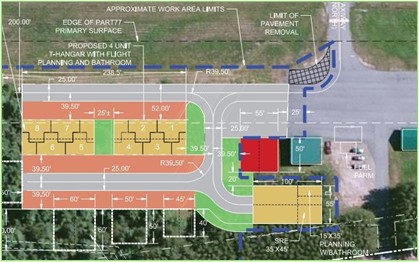Hoyle Tanner designed, permitted and provided construction administration services for a taxilane project at Sugarloaf Regional Airport in Carrabassett Valley, Maine. The 800 linear feet of new 25-foot-wide taxilanes is intended to accommodate future development and generate revenue for the airport by constructing two 4-unit T-Hangars The land needed to be cleared and carefully designed to fit everything in the available space. Currently there are a few box hangars being constructed which should be completed in spring 2024.
Part of the lengthy permitting process included submitting a request to the Federal Aviation Administration (FAA) on behalf of the Airport to request a categorical exclusion (CATEX) in compliance with FAA’s NEPA compliance requirements. Letters of intent from potential investors were needed by FAA in order to prove it would be a valid and valuable project, and deserving of Airport Improvement funds. Several grants were petitioned for – for the design and a second grant for construction.
Previously, two archaeological sites were identified and located within the airport boundary, requiring Hoyle Tanner environmental specialists to confirm that neither of these sites were within the Area of Potential Effect for the proposed project. A Biological Assessment was also prepared to analyze the potential for impacts to endangered species, the Canada lynx and Atlantic salmon. It was determined from this analysis that the project will not affect Atlantic salmon due to use of conservation measures included in the design and construction plans including using reducing the areas of soil disturbance and tree removal and adhering to stringent water quality protection and erosion and sediment controls. The project may affect transitory lynx as they move through adjacent areas, but is not likely to adversely affect the species or individuals due to the low quality of the habitat within the project limits and the infrequency of anticipated use by lynx.
The taxilanes were constructed in 2021 and the final step is underway. While this project faced challenges being constructed during the height of the pandemic, the downstream effects (cost of materials, etc.) have required our team to be flexible and open to alternative ideas and schedules. Thankfully, the airport and our team have worked well together – and thanks to dropping costs, T-Hangar construction should be imminent.
To find out more about the design and permitting projects we do or how we can help your project, reach out to our professionals or see our projects!









